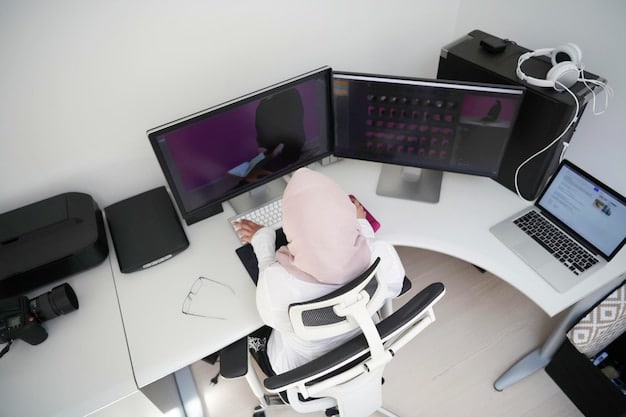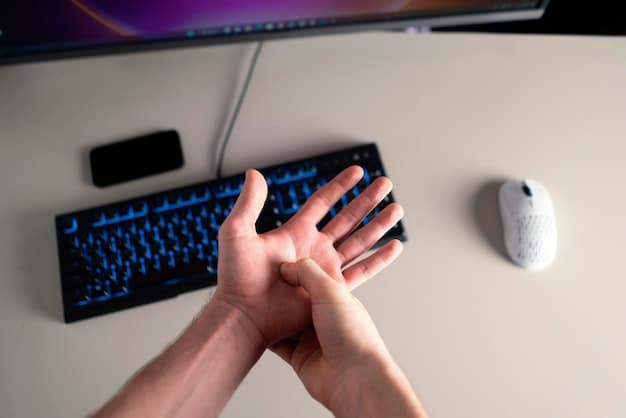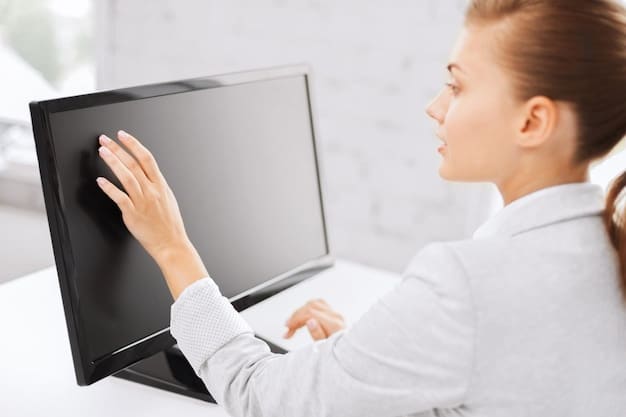PC Gaming Ergonomics: Adjustments to Prevent Strain & Improve K/D

PC gaming ergonomics encompasses adjustments to your setup and habits to minimize physical strain while maximizing performance, potentially leading to improved K/D ratios and a more enjoyable gaming experience.
Are you experiencing aches and pains after long gaming sessions? Does it feel like your performance is being held back by discomfort? The solution might lie in optimizing your PC gaming ergonomics: Prevent Strain and Improve Your K/D Ratio with These Simple Adjustments can make a significant difference.
Understanding the Importance of PC Gaming Ergonomics
PC gaming, while a fun and engaging hobby, can take a toll on your body if proper ergonomics aren’t considered. Prolonged periods of sitting, repetitive movements, and awkward postures can lead to various musculoskeletal issues. Ignoring these problems can lead to chronic pain and diminished gaming performance. However, implementing ergonomic adjustments can significantly reduce these risks.
Why Ergonomics Matter for Gamers
Ergonomics focuses on designing and arranging workplaces, products, and systems so they fit the people who use them. For gamers, this means creating a setup that supports your physical well-being and enhances your gaming experience. It’s about aligning your body in a way that reduces strain and allows you to play comfortably for longer periods.
Common Ailments Among PC Gamers
Many PC gamers experience a range of physical issues due to poor ergonomics. These include carpal tunnel syndrome, neck pain, back pain, eye strain, and even headaches. Addressing these problems early on can prevent them from becoming chronic conditions. Understanding these common ailments is the first step towards improving your gaming setup.

Here are some ailments you should be aware of:
- Carpal Tunnel Syndrome: Occurs due to compression of the median nerve in the wrist, leading to pain, numbness, and tingling in the hand and fingers.
- Neck Pain: Often caused by hunching forward or tilting the head to view the monitor.
- Back Pain: Results from prolonged sitting with inadequate lumbar support.
- Eye Strain: Straining the eyes continuously focusing on a screen for long hours.
By recognizing the potential risks and implementing ergonomic solutions, gamers can significantly reduce their chances of developing these issues and enjoy healthier, more productive gaming sessions. The goal is creating an efficient and safe setup that allows for many years of gaming.
Optimizing Your Gaming Chair for Comfort and Support
Your gaming chair is the foundation of your ergonomic setup. A good gaming chair provides proper support for your back, neck, and arms, helping you maintain a healthy posture during long gaming sessions. Investing in a quality chair can make a significant difference in your overall comfort and well-being.
Key Features to Look For in a Gaming Chair
When selecting a gaming chair, look for features such as adjustable height, lumbar support, armrests, and a headrest. These features allow you to customize the chair to fit your body and provide optimal support. A breathable material can also help prevent overheating during intense gaming sessions.
Adjusting Your Chair for Optimal Posture
Proper adjustment is key to maximizing the benefits of your gaming chair. Start by adjusting the height so that your feet are flat on the floor and your knees are at a 90-degree angle. Ensure that the lumbar support is positioned correctly to support the natural curve of your lower back. The armrests should be adjusted so that your elbows are at a 90-degree angle and your shoulders are relaxed.
Consider the following points when adjusting your chair:
- Seat Height: Adjust so your feet are flat on the floor or on a footrest, with your knees at a 90-degree angle.
- Lumbar Support: Position to support the natural curve of your lower back.
- Armrests: Adjust height and angle to support your forearms and keep your shoulders relaxed.
- Recline: Use the recline feature to occasionally change your posture and reduce pressure on your spine.
By taking the time to properly adjust your gaming chair, you can create a comfortable and supportive seating position that promotes good posture and reduces the risk of pain and discomfort. Regular adjustments ensure that the chair always accomodates your body’s needs, making it an essential component of your ergonomic gaming setup.
Setting Up Your Monitor for Optimal Viewing
The position of your monitor plays a crucial role in maintaining good posture and preventing eye strain. Placing your monitor at the correct height and distance can reduce neck and eye strain and improve your overall comfort. Optimizing your monitor setup is a simple yet effective way to enhance your gaming ergonomics.

Ideal Monitor Height and Distance
The ideal monitor height is when the top edge of the screen is at or slightly below eye level. This position allows you to look slightly downward, which is more comfortable for your neck and eyes. The distance between you and the monitor should be at least an arm’s length. Adjust the distance until you can comfortably see the entire screen without straining your eyes.
Using Monitor Arms for Flexibility
Monitor arms offer greater flexibility in positioning your screen. They allow you to easily adjust the height, tilt, and swivel of your monitor to achieve the perfect viewing angle. Monitor arms can also free up desk space and create a cleaner, more organized gaming setup.
Key benefits here:
- Flexibility: Easily adjust monitor height, tilt, and swivel for optimal viewing.
- Space Saving: Frees up desk space, creating a cleaner and more organized setup.
- Ergonomic Benefits: Allows for precise adjustments to reduce neck and eye strain.
Optimizing your monitor setup is essential for maintaining good posture and preventing eye strain. By following these guidelines, you can create a comfortable and efficient gaming environment that supports your physical well-being and enhances your gaming experience. Correct monitor setup is a simple adjustment that provides long-term benefits.
Choosing the Right Keyboard and Mouse
Your keyboard and mouse are essential tools for gaming, and selecting ergonomic options can significantly reduce the strain on your wrists and hands. Ergonomic keyboards and mice are designed to promote natural hand and wrist positions, minimizing the risk of carpal tunnel syndrome and other repetitive strain injuries. Investing in these peripherals can improve your comfort and performance.
Ergonomic Keyboard Features
Ergonomic keyboards often feature a split design, which allows your hands to rest in a more natural position. Other features include adjustable tilt, cushioned wrist rests, and contoured keycaps. These keyboards are designed to reduce strain on your wrists and forearms, promoting a more comfortable typing experience.
Selecting an Ergonomic Mouse
Ergonomic mice come in various shapes and sizes, each designed to fit different hand sizes and grip styles. Look for a mouse that supports your hand in a neutral position and reduces the need for excessive gripping. Vertical mice are also a popular choice, as they promote a more natural wrist angle.
When choosing a mouse, consider:
- Shape and Size: Choose a mouse that fits your hand comfortably and supports a neutral wrist position.
- Vertical Design: Vertical mice promote a more natural wrist angle, reducing strain and discomfort.
- Adjustable DPI: Allows you to customize the mouse sensitivity to your preferred level.
Choosing the right keyboard and mouse is crucial for maintaining comfort and preventing strain during long gaming sessions. Investing in ergonomic peripherals can make a significant difference in your overall well-being and performance. Correct and neutral wrist and hand positions help prevent long-term injuries.
Taking Regular Breaks and Stretching
Even with the most ergonomic setup, taking regular breaks is essential for preventing fatigue and reducing the risk of musculoskeletal issues. Short breaks throughout your gaming sessions can help you reset your posture, stretch your muscles, and give your eyes a rest. Incorporating regular breaks into your gaming routine is a simple yet effective way to improve your health and well-being.
The Importance of Microbreaks
Microbreaks, which are short breaks lasting a minute or two, can be incredibly beneficial. During a microbreak, simply stand up, stretch your arms and legs, and look away from your screen. These short breaks can help you reset your posture and reduce muscle tension.
Stretching Exercises for Gamers
Incorporate simple stretching exercises into your breaks to further reduce muscle tension and improve circulation. Focus on stretching your neck, shoulders, wrists, and back. Hold each stretch for 15-30 seconds and repeat several times.
Here are some stretches that can benefit gamers:
- Neck Stretches: Gently tilt your head to each side and forward to stretch the neck muscles.
- Shoulder Rolls: Roll your shoulders forward and backward to relieve tension.
- Wrist Stretches: Extend your arms and flex your wrists up and down to stretch the wrist muscles.
Taking regular breaks and stretching is crucial for preventing fatigue and reducing the risk of musculoskeletal issues. Incorporating these habits into your gaming routine can help you stay comfortable and healthy during long gaming sessions. Simple and easy-to-perform exercises will provide immediate relief and long-term well-being.
Additional Tips for Improving PC Gaming Ergonomics
Beyond the basics of chair, monitor, and keyboard setup, several other factors can contribute to improved PC gaming ergonomics. Paying attention to these details can further enhance your comfort and prevent strain during long gaming sessions. Small adjustments can often make a big difference in your overall well-being.
Optimizing Your Lighting
Proper lighting is essential for reducing eye strain. Position your monitor so that it doesn’t reflect direct light sources, and use soft, diffused lighting in your gaming area. Consider using a monitor light bar to provide additional illumination and reduce glare.
Managing Cables and Desk Space
A cluttered desk can lead to awkward postures and increased strain. Organize your cables and peripherals to create a clean and spacious gaming area. Use cable management solutions to keep your desk tidy and prevent tripping hazards.
Enhance your gaming space with these organization techniques:
- Cable Management: Use cable ties, sleeves, or trays to organize and hide cables.
- Desk Organization: Keep essential items within easy reach and remove clutter.
- Ambient Lighting: Use adjustable lights to reduce glare and eye strain.
Pay attention to these additional tips to further enhance your comfort and prevent strain during long gaming sessions. By optimizing everything, you can create a gaming environment that supports your physical well-being and promotes optimal performance. Small, consistent adjustments often provide long-term impact.
| Key Point | Brief Description |
|---|---|
| 💺 Chair Adjustment | Optimize chair height and support to maintain good posture. |
| 🖥️ Monitor Height | Position the monitor at eye level to reduce neck strain. |
| 🖱️ Ergonomic Peripherals | Use ergonomic keyboards and mice to support natural hand positions. |
| ⏱️ Regular Breaks | Take frequent breaks to stretch and rest your eyes. |
Frequently Asked Questions
▼
Ergonomics is important for PC gaming because it helps prevent physical strain and injuries associated with prolonged periods of sitting and repetitive movements. It ensures a more comfortable and healthier gaming experience.
▼
You should aim to take a short break every 20-30 minutes during gaming sessions. These breaks can include standing up, stretching, and looking away from the screen to rest your eyes and reset your posture.
▼
Key features to look for in a gaming chair include adjustable height, lumbar support, adjustable armrests, a headrest, and breathable material. These features allow you to customize the chair for optimal comfort and support.
▼
Position your monitor so that the top edge of the screen is at or slightly below eye level. Maintain an arm’s length distance between you and the screen, and adjust the tilt to reduce glare and eye strain.
▼
Yes, ergonomic peripherals like keyboards and mice can improve your gaming performance by reducing strain and discomfort, allowing you to play for longer periods without fatigue. This can lead to better focus and reaction times.
Conclusion
Incorporating ergonomic adjustments into your PC gaming setup is vital for preventing strain, enhancing comfort, and potentially boosting your K/D ratio. By optimizing your chair, monitor, keyboard, and mouse, and by taking regular breaks, you can create a gaming environment that supports both your physical well-being and your performance. Prioritizing ergonomics is an investment in your long-term health and enjoyment of gaming.





